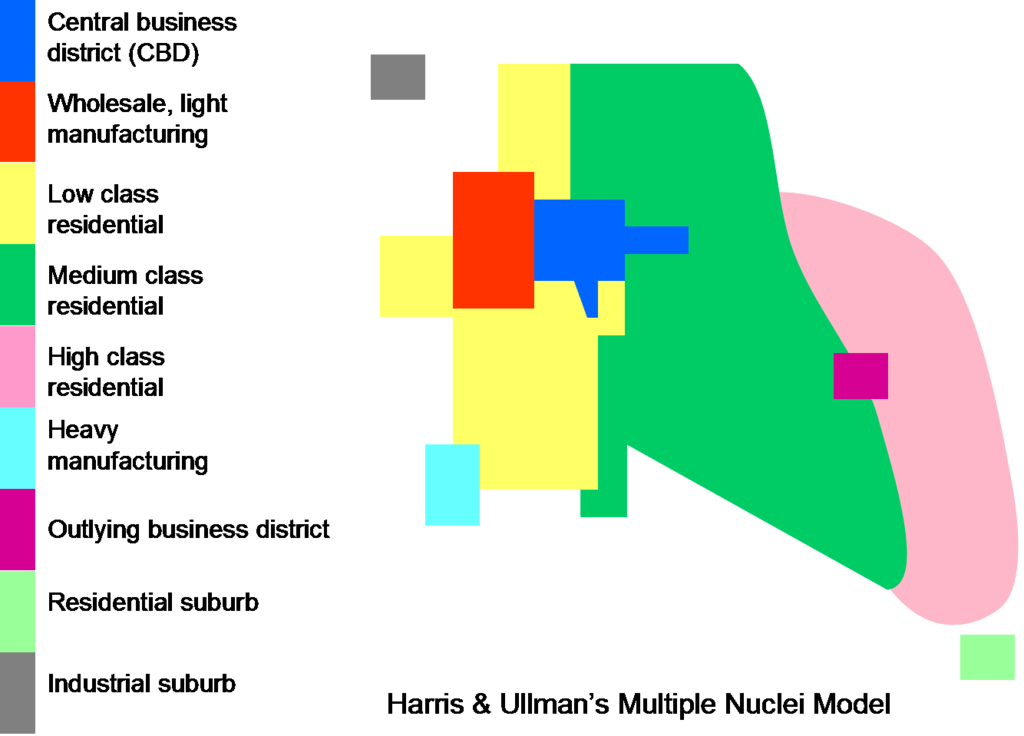Harris And Ullman Multiple Nuclei Model E Ample
Harris And Ullman Multiple Nuclei Model E Ample - It presents cities as having multiple centers or nuclei that influence development, accommodating a diversity of. They argued that the land use pattern is much more complex than the model given by burgress, hoyt & davis. Amandeep lamba explains the multiple nuclei model by ha. However, they note that the ecological structure of cities is varied enough to suggest. The theory was formed based on the idea that people have greater movement due to increased car ownership. In the realm of urban planning, the multi nuclei theory, developed by chauncy harris and edward ullman in 1945, represents a.
Web multiple nuclei model by harris and edward ullman | urban morphology | settlement geography | netmr. Web according to c.d. Web harris and ullman argued that cities do not grow around a single nucleus, but rather several separate nuclei. Examples of cities with a multiple nuclei model include houston, delhi, chicago, london, and sydney. This mobility allows for regional centers to specialize the businesses.
Harris, Were On Active Duty During The Writing Of.
The theory was formed based on the idea that people have greater movement due to increased car ownership. Both urban geographers, edward l. This model suggests that cities develop with multiple centers or nuclei, each serving different functions, rather than expanding from a single central business district (cbd). Web the multiple nuclei model was proposed by c.d.
A Brief Discussion Of The Multiple Nuclei Model By Harris & Ullman, As Well As A Discussion Of The Edge.
19k views 5 years ago cities and urban land use. Examples of cities with a multiple nuclei model include houston, delhi, chicago, london, and sydney. In this chapter and the next the theory will be elaborated to take into account the existence of these ‘multiple nuclei’, and the predictions of the theory will be tested against. Harris and ullman recognized that transportation networks, including roads, railways, and later, highways, played a pivotal role in determining the locations and functions of nuclei.
Amandeep Lamba Explains The Multiple Nuclei Model By Ha.
Adapted from harris and ullman (1945) from publication: Each nucleus acts like a growth point. Web download scientific diagram | 4 multiple nuclei model source: Web an advantage of the harris and ullman multiple nuclei model over the burgess concentric zone model and the hoyt sector model of internal city structure is that the multiple nuclei model easily incorporates depiction of linear and areal physical relief features
Web On The 50Th Anniversary Of The Publication In 1945 Of The Nature Of Cities By Harris And Ullman, With Its Concentric Zone, Sector, And Multiple Nuclei Models Of Internal Patterns Of Cities, An Additional Peripheral Model Is Suggested.
Ullman is based on the argument that the cities have multiple growth points or “nuclei” around which growth take place. This model was given in an article by them “the nature of cities.” Web the multiple nuclei model is a theory of urban land use and structure proposed by geographers c.d. In the realm of urban planning, the multi nuclei theory, developed by chauncy harris and edward ullman in 1945, represents a.
Web harris and ullman proposed multiple nuclei model in their paper the nature of cities ( 1945) to explain the morphology of a city. 19k views 5 years ago cities and urban land use. Web harris and ullman (1945) suggest the unique needs of different industries, businesses, and social (and ethnic) groups lead to the development of cities with multiple nuclei. Further observations are offered on central place, clustered, and linear patterns of distribution of cities. Web multiple nuclei model • developed by c.




